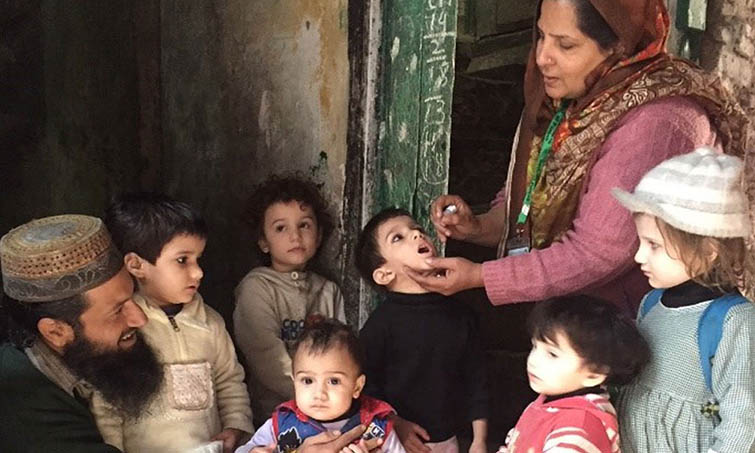UC 29, LAHORE - It’s 2 o clock in the afternoon of a chilly weekday morning in Union Council 29, the old part of Lahore. Ms. Riffat, a Female Community Mobilizer (FCM), stands in the street waiting for the children to return home. Soon she sees the children in distance holding bags and lunch boxes returning from school, she quickly starts organizing her blue vaccine carrier and a white paper attached to a clipboard. As children approach closer, Riffat raises her voice politely and asks smilingly: “did you receive polio drops at school?” Most of the tired-looking children reply to the FCM in an affirmative tone except one child.
After some follow-up questions, Riffat pulls out a vial from her carrier and vaccinates the child. The child gulps two drops of vaccine disapprovingly and walks away to her house with mother waiting behind the door.
Riffat, a mother of four, joined the campaign in Punjab in 2015 after polio teams reported many unvaccinated children during vaccination campaigns, leaving the managers of the programme worried.

Located at a stone throw from the historic Badshahi Mosque and across the notorious red light area, the neighbourhood is home to famous eatery and local delicacy shops. Built in the thin crisscross lanes decades ago, the shops are open all night to serve the visitors as well as locals who prefer to sleep in the morning after all the children have left for school.
“It’s a norm in this part of the city, therefore we adjust ourselves to the needs of the locals and have started visiting the households in the evening”, says Riffat.
“Initially the locals were surprised to see me in the evening, but I explained to them that children especially who have missed vaccination repeatedly are at risk in the neighbourhood. Open sewerage and movement towards high risk districts have increased the risks to children”, the FCM observed.
One of the highest population density, frequent movement to polio high risk districts of Khyber Pakhtunkhwa as well as Federally Administered Tribal Areas and inconsistent routine immunization has put the union council poses serious challenges in polio eradication efforts.
Over 7,000 children under five live in the UC and half of them have roots in areas which are considered hotbeds of polio virus.
Polio teams spend hours vaccinating every child in the households as it’s difficult to track in these intertwined and rusty structures inhabited by the population.
Lack of attention on the part of caregivers resulted in large number of children not receiving vaccine in official five days of the campaign.
“Previously at the end of five days we had 50 per cent of the children who were without vaccine. The teams visited in the morning, knocked at the doors regularly but without any avail”, says Irfan Shafi, the UC Medical Officer Irfan Shafi.
“As soon as Riffat started visiting the UC in the evening things have changed. She asked for a convenient time of vaccination from the caregivers. Now it is regular practice that polio teams follow up children after they return from school and are ably joined by Riffat bibi”, adds Shafi.
“Vaccination during campaigns is now 100 per cent. The good part is that Riffat continues vaccination even after the five-day campaign has finished till all the children have been vaccinated”, observes Mr. Shafi.
In Lahore, 42 community mobilizers are making a difference. They support children and caregivers accessing basic health services. They have also helped expand the pool of children eligible for vaccines at the right age and thus helped save hundreds of children from vaccine-preventable diseases like polio.
Lahore holds the key to the fight against polio in Punjab as well as all over Pakistan. It is one of the most favourite destinations of the families who are travelling in search of livelihood and shelter.
On average, over 50,000 children belonging to families who are on the move is vaccinated in Lahore in every campaign. The numbers are second to Rawalpindi only where 70,000 such children are vaccinated every campaign.
Lahore has been in the spotlight in 2017 when a child in Diamer, Gilgit Baltistan was diagnosed with polio. The roots of the virus were traced back to movement of population from Lahore. In January 2018, environmental sample collected from Lahore’s Outfall Road tested positive indicating more children were at risk in the city.
“In a situation where we have evidence of virus circulation any child who has not received oral polio vaccine is at risk. The government cannot afford to take risk of leaving any child without vaccine. The parents have to be very careful”, cautions Dr Munir Ahmad, the Coordinator of the Punjab Emergency Operations Centre.
Pakistan Polio Eradication Programme has come a long way toward building a future in which polio no longer endangers children, families, and communities across our country. The programme registered an 97% drop in cases from the dire situation of 2014 - cases consistently dropped from highs of 306 to 54 in 2015 to 20 in 2016, and 8 in 2017.
“My neighborhood is located in the heart of old Lahore and home to very friendly people. So I respond to them equally well by taking care of their children who are at heightened risk of polio in the city. I am a Sehat Muhafiz, are you”, Riffat asks with a broad smile on her face.
